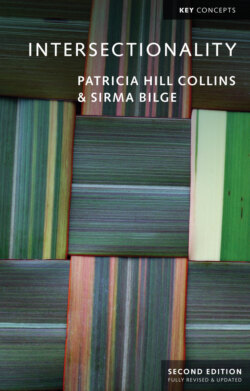Читать книгу Intersectionality - Patricia Hill Collins - Страница 9
Using Intersectionality as an Analytic Tool
ОглавлениеPeople generally use intersectionality as an analytic tool to solve problems that they or others around them face. Most colleges and universities in North America, for example, face the challenge of building more inclusive and fair campus communities. The social divisions created by power relations of class, race, gender, ethnicity, citizenship, sexuality, and ability are especially evident within higher education. Colleges and universities now include more college students who formerly had no way to pay for college (class), or students who historically faced discriminatory barriers to enrolment (race, gender, ethnicity, indigeneity, citizenship status), or students who experience distinctive forms of discrimination (sexuality, ability, religion) on college campuses. Colleges and universities find themselves confronted with students who want fairness, yet who bring very different experiences and needs to campus. Initially, colleges in the US recruited and served groups one at a time, offering, for example, special programs for African Americans, Latinx groups, women, gays and lesbians, veterans, returning students, and persons with disabilities. As the list grew, it became clearer not only that this one-group-at-a-time approach was slow, but that most students fit into more than one category. First-generation college students could include Latinos, women, poor whites, returning veterans, grandparents, and transgender women and men. In this context, intersectionality can be a useful analytic tool for thinking about and developing strategies to achieve campus equity.
Ordinary people can draw upon intersectionality as an analytic tool when they recognize that they need better frameworks to grapple with social problems. In the 1960s and 1970s, African American women activists confronted the puzzle of how their needs concerning jobs, education, employment, and healthcare simply fell through the cracks of antiracist social movements, feminism, and unions organizing for workers’ rights. Each of these social movements elevated one category of analysis and action above others; for example, race within the civil rights movement, or gender within feminism, or class within the union movement. Because African American women were simultaneously black and female and workers, these single-focus lenses on social inequality left little space to address the complex social problems that they face. Black women’s specific issues remained subordinated within each movement because no social movement by itself would, or could, address the entirety of discriminations they faced. Black women’s use of intersectionality as an analytic tool emerged in response to these challenges.
Intersectionality as an analytic tool is neither confined to nations of North America and Europe nor a new phenomenon. People in the Global South have used intersectionality as an analytic tool, often without naming it as such. Consider an unexpected example from nineteenth-century colonial India in the work of Dalit social reformist Savitribai Phule (1831–97), regarded as an important first-generation modern Indian feminist. In an online article titled “Six Reasons Every Indian Feminist Must Remember Savitribai Phule,” published in January 2015, Deepika Sarma suggests:
Here’s why you should know more about her. She got intersectionality. Savitribai along with her husband Jyotirao was a staunch advocate of anti-caste ideology and women’s rights. The Phules’ vision of social equality included fighting against the subjugation of women, and they also stood for Adivasis and Muslims. She organized a barbers’ strike against shaving the heads of Hindu widows, fought for widow remarriage and in 1853, started a shelter for pregnant widows. Other welfare programmes she was involved with alongside Jyotirao include opening schools for workers and rural people, and providing famine relief through 52 food centers that also operated as boarding schools. She also cared for those affected by famine and plague, and died in 1897 after contracting plague from her patients.
Phule confronted several axes of social division, namely caste, gender, religion, and economic disadvantage or class. Her political activism encompassed intersecting categories of social division – she didn’t just pick one.
These examples suggest that people use intersectionality as an analytic tool in many different ways to address a range of issues and social problems. One common use of intersectionality is as a heuristic, a problem-solving or analytic tool, much in the way that students on college campuses developed a shared interest in diversity, or African American women used it to address their status within social movement politics, or Savitribai Phule advanced women’s rights. Even though those who use intersectional frameworks all seem to be situated under the same big umbrella, using intersectionality as an analytic tool means that it can assume many different forms because it can accommodate a range of social problems.
In this book, we examine multiple aspects of intersectionality but, for now, we want to show three uses of intersectionality as an analytical tool. In line with Cho et al.’s argument that “what makes an analysis intersectional is not its use of the term ‘intersectionality,’ nor its being situated in a familiar genealogy, nor its drawing on lists of standard citations,” our focus is on “what intersectionality does rather than what intersectionality is” (2013: 795). Our cases of how intersecting power relations characterize international football, the growing recognition of global social inequality as an intersectional phenomenon, and the emergence of the black Brazilian women’s movement in response to specific challenges of racism, sexism, and poverty illustrate different uses of intersectionality as an analytic tool. Specifically, they suggest how intersectional analyses of sports illuminate the organization of institutional power, how intersectionality has been used to diagnose social problems, and how intersectional responses to social injustices enhance activism. These cases both introduce important core ideas of intersectional frameworks and demonstrate different uses of intersectionality as an analytic tool.
